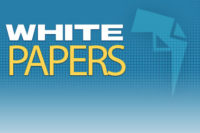Dairies create tough environment for label application equipment. That’s why Cloverland Dairies has been running labeling equipment from WS Packaging Group since 2002.
The “Got Milk?” advertising campaign is one of the most successful ad campaigns ever. It’s been around since October 1993 and has a 90% consumer recall rate. While the campaign promotes milk in general, today’s dairy case sports a host of milk options. From whole to fat-free skim, strawberry to vanilla, chocolate to banana, gallons to single-serve bottles for people on the go, consumer demand for variety has created opportunities for dairy operations.
Of course, with increased product demand comes increased operational demands. Next to product quality, key concerns for dairies are bottling line speeds and the operating environment. The filling side of dairies is cold and excessively humid, which can be challenging for equipment, especially label applicators. Along with the cold and wet conditions, there’s indirect contact with caustic washdown solutions and various milk products. All these factors combine to create a harsh environment that’s tough on equipment. It also poses a risk to operators because of the electricity.
“Dairies are typically very wet environments, which are not friendly to paper label materials and the machinery that runs them,” said Doug Johnson, plant engineering manager with Cloverland Farms Dairy, based in Baltimore City, Md. “So, keeping water away from the equipment is important.”
Cloverland has been running labeling equipment from WS Packaging Group since 2002. The machines are used to apply side panel and wrap labels to a variety of products in different sizes that include both white and chocolate milks, juices, flavored drinks and bottled water.
For WS Packaging, overcoming the environmental challenges literally began on the drawing table.
“We design our dairy labelers specifically for this tough environment,” said Todd Bogard, dairy sales manager for WS Packaging, headquartered in Green Bay, Wis. “Our very first machine was built for the dairy industry. Durable functionality is key. The machines stand up to the environment, yet they are easy to operate and maintain. We have machines throughout the dairy industry that are still going strong after 20-plus years.”
Cloverland currently operates 10 pieces of installed label application equipment from WS Packaging. From its original style Roll-Tak 200 unit to its High-Speed School Lunch Wrap Labeler, the range of equipment hits labeling rates from 50 to more than 380 bottles per minute.
“Dairy operations are all about production when it comes to setting up their equipment,” said Kevin Bricker, senior account manager with WS Packaging. “Cloverland gave us the layout for its facility and asked us to make the equipment fit. It’s not a cookie-cutter set up. We had to do some base and stand customizing with several of the applicators because they’re placed very close to fillers and walls.
“Cloverland designed the lines, and we designed our equipment to address their space demands. But despite the tight footprint, we had no trouble integrating the equipment and fully meeting their production requirements.”
Like any manufacturing operation, efficiency is vital. Being able to consistently and cost effectively get your product to market is a competitive advantage. Maintaining that competitive advantage ensures you stay a viable business. Cloverland rates its operational efficiency on the basis of up-time rates and set-up time.
“When we change bottle sizes a mechanic is usually needed to assist, but it isn’t something we do very often,” Johnson explained. “Outside of that, daily setup time is pretty short and straightforward. Once the machines are set on a particular bottle size, they repeatedly produce well without any mechanic involvement. Label changes are very routine and always performed by the operators.”
Being able to respond to changes in the industry has helped Cloverland stay competitive. It has completely done away with cartons. The move required the installation of a wrap labeler for the 8- by 2-inch label on products targeted for schools and institutions. The dairy also followed the industry’s move to front and back labeling for gallon and half-gallon milk containers. The prime label on the front is for branding-related information, while the back label now carries all the nutritional and ingredient requirements.
“We installed a back labeler to the appropriate lines and the integration was seamless,” Bricker said. “While the additional label does add another consumable to the operational mix, we’ve been able to maintain the same line speeds.”
Another move by Cloverland to stay competitive involves special on-pack promotions, such as co-branding efforts and instant-redeemable coupons. WS Packaging installed a dedicated applicator in-line to accommodate the additional materials.
All the label application equipment at Cloverland is in a single plant. And along with the easy operator set-up, equipment design yields further operational efficiencies in the form of cost-effectiveness due to minimal power requirements (120 VAC, 15 amps). Other design features include left- and right-hand configurations, which makes it possible to adapt equipment to the most complex dairy facility. Specialized product handling components ensure consistent and precise label placement.
The user-friendly design equally accommodates operators and maintenance staff. The open-frame label head assembly allows for easy maintenance, and the industry standard electrical enclosures comply with the National Electrical Manufacturers Association to meet the demands of the constantly cold and damp operating environment.
“From a reliability standpoint, there are subtleties to be learned for each piece of equipment,” Johnson notes. “But once mastered, the labelers have become very reliable.”
Cloverland/Green Spring Dairy is located in Baltimore City, Md. Its products can be found in hospitals, private and public schools, institutions, convenience stores, supermarkets, and other outlets. It also supplies most restaurants, airports and hotels throughout Baltimore, Washington, D.C., and northern Virginia.
Get our new eMagazine delivered to your inbox every month.
Stay in the know on the latest dairy industry trends.
SUBSCRIBE TODAYCopyright ©2024. All Rights Reserved BNP Media.
Design, CMS, Hosting & Web Development :: ePublishing
